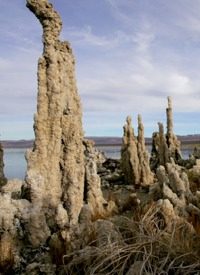
NASA’s anticipated press conference concerning a breakthrough in astrobiology proved once again that life is stranger than scientists had known, but not as strange as some reporters and bloggers might have hoped.
Interest in the upcoming conference began not long after a relatively innocuous NASA press release on November 29, announcing the agenda for an upcoming briefing on a significant discovery:
NASA will hold a news conference at 11 a.m. PST on Thursday, Dec. 2, to discuss an astrobiology finding that will impact the search for evidence of extraterrestrial life. Astrobiology is the study of the origin, evolution, distribution and future of life in the universe.
Despite the almost banal tone of NASA’s press release, speculation concerning the upcoming conference quickly took on a life of its own — so to speak. An article at FoxNews.com was typical of the tone, headlining “NASA to Unveil Details of Quest for Alien Life” complete with a still frame from the movie E.T., and the caption, “Will we find evidence of a real-life E.T. in the very near future?” FoxNews was far from alone in building the wave of media and Internet hype; an article by astrobiologist Lewis Dartnell for the Guardian (“Arsenic, bacteria and alien life: Lessons from an internet frenzy”) reconstructs, at least in part, the devolution from a news conference to a three-ring circus:
On Monday, blogger Jason Kottke speculated that Nasa had discovered arsenic on Saturn’s moon Titan and evidence for alien bacteria growing on it. From here the echo chamber and game of Chinese whispers that is the internet and blogosphere went into overdrive.
Speculation was running rife, with some blogs proclaiming that Nasa was about to announce the discovery of extraterrestrial life, or evidence of a “shadow biosphere” of terrestrial organisms unrelated to us, and so forming a separate tree of life on our planet.
This was a great leap to make from Nasa’s description of a “finding that will impact the search for extraterrestrial life”….
The more interesting tale here, I think, is how this engine of speculation revved up as the story played out. Nasa certainly hadn’t over-hyped anything: they posted a very modest, if somewhat enigmatic, notification of a press conference.
But could the agency perhaps have handled the subsequently developing situation better? Both Nasa and Science, along with the researchers, kept stoically silent all week. With speculation running wild, perhaps they should have announced their actual findings earlier than planned.
Regardless of any speculations regarding the way in which NASA could have better managed the story, the breakthrough in the study of biology unveiled on December 2 is absolutely fascinating and challenges what was known previously about the nature of life on Earth — and, potentially, elsewhere. Scientists have now discovered a bacteria that utilizes arsenic instead of phosphorus as one of the “building blocks” of life, a substitution that is thus far unique in mankind’s study of nature, and a discovery that significantly alters the way in which science may reasonably speculate about the nature of life elsewhere in the universe. As Melissa Bell wrote for the Washington Post:
After two days of flurries of speculation about NASA’s Thursday announcement, an answer finally seems clear: NASA did not find alien life, but it did find a new life form here on Earth. A team of scientists discovered a bacteria in California that lives off arsenic.
Before you get disappointed, realize that while not as sexy as a little green man, it is a big deal. No other life form exists off arsenic. It had long been the assumption that without six certain essential elements — carbon, hydrogen, nitrogen, oxygen, phosphorus and sulfur — life could not exist. This discovery shows “life-as-we-know-it could be much more flexible than we generally assume or can imagine,” Felisa Wolfe-Simon a NASA biochemist told the Post’s Marc Kaufman.
At the end of the press conference, “E.T.” remained as elusive as before, but a significant advance in the study of life demonstrated once again that humanity’s scientific knowledge is still quite limited, and the future may hold many more advances. Study continues on the seasonal appearance of methane in Mars’ atmosphere, and Thursday’s conference is likely to heighten interest in the search for life on Titan. Scientific facts may not always live up to human anticipation and speculation, but mankind’s fascination with the unknown will continue to drive our study of creation.
Photo of Mono Lake, in California, where the bacteria was found: AP Images



